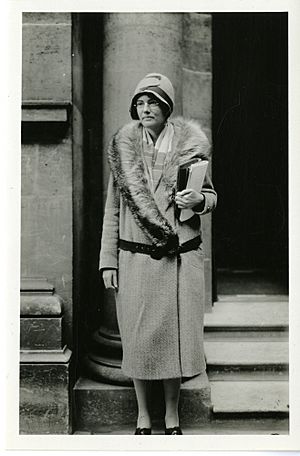Constance Endicott Hartt facts for kids
Constance Endicott Hartt (born November 2, 1900 – died December 21, 1984) was an important American botanist. A botanist is a scientist who studies plants. She is especially known for her research on sugarcane, which is a tall grass used to make sugar.
Hartt was born in Passaic, New Jersey. She went to Mount Holyoke College and graduated in 1922. After college, she taught science at St. Lawrence University and Connecticut College. Later, she moved to Hawaii and became a botanist for the Hawaiian Sugar Planters' Association. This organization worked to improve how sugarcane was grown. Hartt passed away in Hawaii in 1984.
Contents
What is Sugarcane?
Sugarcane is a type of grass that grows very tall, sometimes over 20 feet high! It stores a lot of sugar in its stems. People have been growing sugarcane for thousands of years to make sugar, molasses, and even fuel. It grows best in warm, sunny places, like Hawaii.
How Sugarcane Makes Sugar
Sugarcane, like all green plants, makes its own food through a process called photosynthesis. This is how plants use sunlight, water, and carbon dioxide from the air to create sugars. These sugars are then stored in the plant. For sugarcane, the goal is to grow plants that produce as much sugar as possible.
The Role of Photosynthesis
Photosynthesis is super important for sugarcane. The more efficiently a sugarcane plant can photosynthesize, the more sugar it can make. Scientists like Constance Hartt studied how different things, like the amount of sunlight or water, affected this process. They wanted to find the best conditions for sugarcane to grow and produce sugar.
Hartt's Research on Sugarcane
Constance Hartt spent many years studying sugarcane in Hawaii. Her main goal was to understand how sugarcane plants make and store sugar. She wanted to find ways to help farmers grow healthier plants that produced more sugar. This was very important for the sugar industry in Hawaii.
Studying Sugar Production
Hartt did many experiments to see how sugar moved around inside the sugarcane plant. She looked at how the leaves, stems, and roots worked together. She found out how different parts of the plant stored sugar and how it was transported from where it was made (the leaves) to where it was stored (the stems).
Impact of Light and Temperature
One of Hartt's key areas of research was how light and temperature affected sugarcane. She discovered that the amount of sunlight a plant received could change how much sugar it produced. She also studied how different temperatures influenced the plant's growth and sugar content. Her findings helped farmers choose the best times and places to plant sugarcane.
Using Radioactive Tracers
To understand how plants work, scientists sometimes use special tools. Constance Hartt was one of the first scientists to use radioactive isotopes (like a tiny, harmless "tracer") to follow the path of carbon dioxide as it turned into sugar inside the sugarcane plant. This was a very advanced technique for her time.
Tracing Carbon's Journey
By using these tracers, Hartt could see exactly where the carbon (from carbon dioxide) went after the plant took it in. She could track its journey as it became part of the sugars. This helped her understand the complex process of photosynthesis and sugar storage in sugarcane in amazing detail. Her work helped other scientists learn more about how plants make food.
Why Her Work Mattered
Constance Hartt's research was very important for the sugar industry. By understanding how sugarcane plants make and store sugar, farmers could improve their growing methods. This meant they could grow more sugar with less effort, which helped the economy of Hawaii.
Her scientific discoveries also helped other plant scientists around the world. She showed new ways to study how plants work, especially how they create and use energy. Her dedication to understanding plants made a lasting impact on botany and agriculture.


